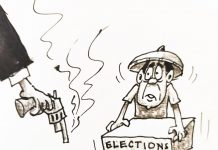Kneejerk policies crafted in haste had brought undue punishment upon victims of the devastation wrought by super typhoon Yolanda. It came as castigation upon the fallen victims who could hardly get up from the ruins upon their lives, homes and livelihood. The ban to rebuild structures within forty meters from the shoreline came as a protective measure aimed at promoting the welfare of the people. The policy appears lacking deliberation particularly on its consequential effects upon the lives of the people who remain struggling from the ruins of the super typhoon Proscribing people from building back their homes that were erected in what were considered danger zones for being too close to sea waves.
Policymakers were motivated with what to them are good intentions to protect the people from prospective waves they foresaw rushing to the shores in magnitudes that may surpass the wickedness of super typhoon Yolanda. But the policy was formulated akin to a class legislation that selectively took for its subject the people who were toppled by the storm surges. Knocked down if not out, these people must be barred from returning to the place were they were caught by the onslaught of tall waves lambasting homes, chiefly those that stood near and along shorelines.
But the reactive policy unduly placed the fallen Yolanda victims scampering to nowhere. We know too well that most of the people living along shorelines, especially in urban areas, are those who do not have lands for their abode. These people took the risk of living too close to the perils of the sea not by their own convenience but due to the push of their impoverished condition. Many of the people in coastal communities live in such areas to sustain their lives from fishing and other livelihood activities at sea. In some instances, these coastal communities are located in zones that are classified as timberlands which are by law inalienable and could never be owned privately.
The ban from getting back in such coastal areas where they were felled by the storm surge had practically pushed them to a hopeless situation. The marching order that followed for these people to relocate to higher grounds for their safety. But even higher grounds could not be considered hazard-free as there are other perils aside from sea waves and storm surges. People living in coastal areas are usually not owners of lands on mountains and hills. Victims as they are, these people are struggling for survival to fill their basic needs, chief of them food more than shelter. They remain powerless to locate for themselves, any alternative place which they could consider safe for their abode.
Ironically, government, with all its powers and resources, could hardly pinpoint relocation sites that it commands typhoon victims to go to as best alternative from where they had declared as “no build zones”. The tough task had been passed to the local government units that are victims as well and are in limbo responding to the multifarious needs of tis constituents. Amid the ruins, victims of the super typhoon are stills living in tents that had started to wear out from over eight months under the heat of the scorching sun, the downpours of heavy rains and the forces of the stormy winds. People in the devastated areas continue to ask the nagging question . . . where to?




